Advice from the Field: Initiating, Sustaining, and Scaling Personalized, Competency-Based Learning
CompetencyWorks Blog
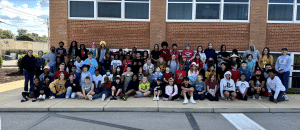
During the 2020-2021 school year, my colleagues, Dr. Emily Difani and Dr. Sarah Moran, and I launched Pirate Academy, a personalized, competency-based learning program housed within a traditional middle school in Pattonville School District, Missouri. Over the past three school years, I have taught ELA, social studies, and reading intervention to students in the sixth, seventh, and eighth grades in mixed-age classes. Our expectations of positive outcomes have become a reality, as demonstrated by concrete evidence that this type of system does truly impact student achievement.
Prior to launching this personalized, competency-based learning program, I taught in a traditional 8th-grade English language arts classroom. I humbly confess that my practices inadvertently left many students behind. I spent these years stressed that my instructional practice was not positively impacting student success, as evidenced by the apathy and disengagement of my students.
Five years into my career, I discovered personalized learning – and it opened the door to a world of research and pedagogy that was both foreign and exciting. It gave me hope for our broken system. I am fortunate to be in a school district that is committed to this work. With their support, we began planning for Pirate Academy in 2019.
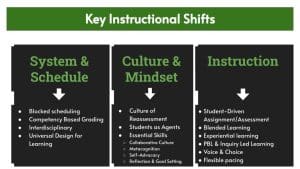
We designed key instructional shifts in structures, culture, and pedagogy (or instruction) as summarized in the chart above. We are just three years in and each year we have grown Pirate Academy by adding an additional grade level.
| Year 1 | 2020-2021 | Year 2 | 2021-2022 | Year 3 | 2022-2023 |
| 6th grade | 6th & 7th grades | 6th, 7th, & 8th grades |
Because of our gradual build, we will not have a complete data set representing the impact of personalized, competency-based learning and grading on grades sixth through eighth until the end of this school year. However, preliminary data on a district-wide, standardized, nationally-normed benchmark test from 2021-2022 demonstrates significant statistical differences for seventh-graders who were in Pirate Academy for two grade levels in math and reading compared to students in traditional seventh-grade classrooms. Other indicators of success are our discipline data and transferable skills development. Students in Pirate Academy have a very low percentage of office referrals, suspensions, and detentions. Our students also exhibit excellent 21st-century skills, specifically in self-advocacy, engagement, collaboration, reflection, and leadership.
Examples of Student Success in Action
Below are some stories of student success in Pirate Academy beyond what students typically experience in a traditional middle-school learning environment.
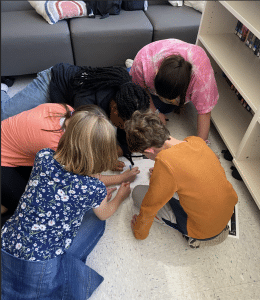 Meeting Students Where They Are
Meeting Students Where They Are
One sixth grader had received math intervention throughout her elementary experience but never achieved mastery. In a traditional math classroom, she would have earned a D or F because she failed or barely passed every math test. This student was diagnosed with a math disability near the end of the school year and qualified for an IEP. Fortunately, she was in Pirate Academy, which prioritizes reassessment, personalized pacing, and competency-based learning. As a result of an ongoing math workshop and support from her teacher, this student was able to master every sixth-grade math standard by the end of the year. This is the first year she was able to successfully master math content. This was the first year she wasn’t left behind.
Our personalized, competency-based learning pedagogy also supports students who typically struggle in one or more content or skill areas, including the writing process. While teaching in a traditional ELA classroom, I always had a handful of students who did not produce any writing within a given timeline and, thus, left eighth grade without ever writing a piece for me to assess. The competency-based grading and personalized pacing used in Pirate Academy allows every student to be successful. We meet the students where they are in the writing process, provide targeted support and feedback, and don’t stop until the learning targets have been mastered. These are my first years of teaching in which a majority of students have completed writing tasks successfully.
Enabling Students To Move On
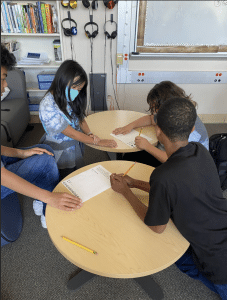 Students in Pirate Academy have flexible pacing in mathematics through a flipped-learning model. As a result, students are able to work through the mathematics curriculum at their own pace, allowing students who are ready to demonstrate mastery of content beyond what teachers cover within a traditional math classroom. We have many students who master multiple grade levels worth of math standards within a school year, advancing to the next course when they are ready. This would not be possible in a traditional math classroom.
Students in Pirate Academy have flexible pacing in mathematics through a flipped-learning model. As a result, students are able to work through the mathematics curriculum at their own pace, allowing students who are ready to demonstrate mastery of content beyond what teachers cover within a traditional math classroom. We have many students who master multiple grade levels worth of math standards within a school year, advancing to the next course when they are ready. This would not be possible in a traditional math classroom.
We use blended learning models to create 1-3-week playlists for students to work through skills and content at their own pace within a given unit in English language arts and social studies. All students have access to enrichment and intervention during this time, but students who are ready have access to an honors-level project in which they have free choice. In this project, students determine their topic and codesign a learning and mastery path with the teacher for each level of Marzano’s taxonomy. Throughout the years I have had students demonstrate significantly advanced learning. I’ve had multiple students write 200-400 page novels and develop expertise around topics such as quantum physics, engineering, engine design, art appreciation, culture studies, and career exploration.
Cultivating Learning Disposition
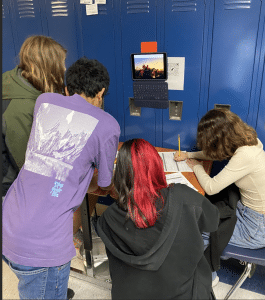 One student who transferred into Pirate Academy as an eighth-grader had spent two years in a traditional middle school setting and was initially very challenged by the culture and norms around grading in Pirate Academy. Because of her previous middle school experience, she was used to turning in partially completed assignments or avoiding assignments altogether, preferring a C or D to actually putting in the effort. She was very frustrated early in the school year when her teachers wouldn’t accept partially completed assignments. She frequently bemoaned the fact that her teachers wouldn’t just give her a D or F grade and let it go. Another eighth-grade student who has been with us since 6th grade spoke up, telling her that in Pirate Academy we care about learning, not just finishing. Since then, she has gotten on board with the fact that we care about mastery and has realized that opting out of learning is not an option in Pirate Academy.
One student who transferred into Pirate Academy as an eighth-grader had spent two years in a traditional middle school setting and was initially very challenged by the culture and norms around grading in Pirate Academy. Because of her previous middle school experience, she was used to turning in partially completed assignments or avoiding assignments altogether, preferring a C or D to actually putting in the effort. She was very frustrated early in the school year when her teachers wouldn’t accept partially completed assignments. She frequently bemoaned the fact that her teachers wouldn’t just give her a D or F grade and let it go. Another eighth-grade student who has been with us since 6th grade spoke up, telling her that in Pirate Academy we care about learning, not just finishing. Since then, she has gotten on board with the fact that we care about mastery and has realized that opting out of learning is not an option in Pirate Academy.
All but a handful of students in our program have become self-proclaimed readers during their time at Pirate Academy. We have a culture of reading in the classroom that has resulted in countless students changing from reluctant to engaged readers. Because our teachers loop with our students (staying with the same students for multiple years), I have seen many grow over time from below grade level to significantly above on their standardized reading tests.
Reflections on the Change Process
Change like this takes time. I’d be lying if I said that every teacher in our building is on board with changing the system, even after observing this incredible success. Those still resistant are comfortable in the current system and do not see a need to change. This type of mindset is very common in education but is not an impossible barrier to overcome.
Here’s my advice to school systems wanting to initiate and sustain personalized, competency-based learning:
Target your change makers.
If we want to make systemic change, we must get teachers on board. Leaders must identify staff who are willing and ready to improve the system and train, support, and guide them to deeply understand why this change needs to happen.
Evaluate the impact of practice on student learning.
Leadership teams must evaluate every practice within a school to determine the impact on student learning. They must highlight instructional practices that are harming students and those that are helping, engage in professional development to promote best practices, and prioritize focusing on student learning in departmental and building-level conversations.
Ask questions to change minds.
Staff need to be confronted with the ways in which the traditional school system is failing students, but understanding is most often achieved through good questioning. In order for this change to happen, teachers must see the flaws in our current system and take personal ownership to drive this change toward more learner-centered practices. Obviously, there are students who are doing well, despite the systemic issues, but why do they succeed when others don’t? Is it the result of our strategies? What about the kids with gaps in their learning? What about the kids experiencing poverty? What about the kids who your instruction moves too fast for? What about the kids who are ready for more? What do we do when students don’t master a skill? If we say it is important, why do we just move on when they haven’t mastered it? Do we know where students are struggling? Do we know how to provide intervention to close learning gaps? How can we maximize our system to meet our diverse learners and their learning variability? How can we mobilize students by increasing agency and voice? How can we better target student learning gaps, strengths, and areas for advancement?
Share the vision, make an action plan, and take a step.
When teachers see concrete evidence of the differences between learners in a traditional classroom compared to those in a personalized, competency-based system, they will notice a stark contrast in student success. This change is worthwhile, but I know firsthand how overwhelming it can feel to get started. Keep your vision in mind, make a reasonable action plan, and take the first step. Then reflect, course correct, and take another step. Once you get going, momentum and a committed community of changemakers will see the vision through. As Georg C. Lichtenberg said, “I cannot say whether things will get better if we change; what I can say is they must change if they are to get better.”

Learn More
- An Introduction to Competency-Based Education with Students and School Leaders
- 4 Keys to Building Deeper Critical and Creative Thinking in Your Classroom
- CBE Starter Pack 4: Progress Based on Mastery
 Maegan Bowersox teaches English language arts, social studies, and reading intervention in the Pirate Academy at Holman Middle School, located in St. Louis, MO. She also serves as the ELA Department Leader at Holman, is on multiple building and district leadership committees, has been a student and practitioner of personalized learning for 5+ years, and is passionate about innovation, competency-based grading, and learner-centered instruction.
Maegan Bowersox teaches English language arts, social studies, and reading intervention in the Pirate Academy at Holman Middle School, located in St. Louis, MO. She also serves as the ELA Department Leader at Holman, is on multiple building and district leadership committees, has been a student and practitioner of personalized learning for 5+ years, and is passionate about innovation, competency-based grading, and learner-centered instruction.